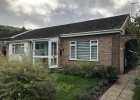Herefordshire Green Doors 2022
1 Oct - 1 Nov 2022
This event has now finished.
Book ahead
Claire and Huw welcome you to their modernist style Passivhaus finished in 2017.
Green features:
The house was built highly insulated and airtight, with triple glazed windows, heat recovery ventilation, a small gas boiler for the hot water and underfloor heating, 5.6 kWp solar panels, immersion diverter, a 6.5 kWh Tesla Powerwall battery, a Zappi smart EV charger, a permeable green drive and a well which supplies the toilets, utility room and outdoor tap.
Last year we added sedum modules over part of our roof, a 13.5 kWh Powerwall 2 battery and a small 5kw Mitsubishi air source heat pump. This was expected to need to call on the gas boiler on the coldest days, but actually managed so easily by itself that we have now disconnected our gas supply.
Motivations to make changes:
We wanted a house for our retirement which would be as resilient as possible to all the coming impacts of climate change and offer a refuge for ourselves and others in the face of extreme weather events, unreliable energy supplies and social instability, as well as being comfortable to live in and consuming a minimum of fossil fuel energy in the meantime. The original build met a lot of our aims, but as technology moved on, we realized we could do better still.
Approximate costs:
Sedum £1.5k; Battery £11k; Heat pump £8k
Approximate energy savings:
Our electricity consumption from the grid over the past year was around 2.7 MWh, including heating and car charging. For comparison, the average UK 2021 household electricity consumption was 3.7 MWh, which would usually not include either.
We are on a special tariff for electric car owners giving four hours of night time electricity at only 5p per kWh, so we use that window to charge the car and run the dishwasher, and during winter also charge up the Powerwall 2 so that we use an absolute minimum of higher rate electricity.
In previous years, without the second battery or the heat pump, we used about 3 MWh of gas and 1.3 MWh of electricity, so the saving in overall energy use was 1.6 MWh pa.
The green roof may well also have kept the house a little warmer in winter and cooler in summer, but this is hard to quantify.
Benefits:
The house was pretty comfortable already, but the changes have made it more energy efficient. We are now virtually independent of the grid in the summer months and could get by for several days in a power cut in the winter months.
Next steps:
The house was designed to have two horizontal louvred shade elements in front of the tall windows on the stairwell. We didn’t want it to block the view, so left them out. So far we have been able to keep the house cool in heatwaves by letting air in at night, but as they become more frequent and intense, we expect to need further shading.
This event has now finished.


